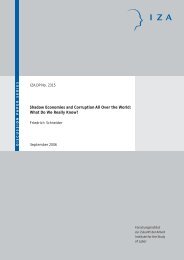The Great Recession of 2008-2009: Causes ... - Index of - IZA
The Great Recession of 2008-2009: Causes ... - Index of - IZA
The Great Recession of 2008-2009: Causes ... - Index of - IZA
- TAGS
- recession
- index
- ftp.iza.org
You also want an ePaper? Increase the reach of your titles
YUMPU automatically turns print PDFs into web optimized ePapers that Google loves.
labour market policy measures that do not require complex institutional structures and social<br />
dialogue. Nonetheless, some governments are turning to more innovative policies that have<br />
not been widely used before such as providing subsidized training for threatened workers.<br />
<strong>The</strong> effectiveness <strong>of</strong> labour market policies during the global financial crisis <strong>2008</strong>-<strong>2009</strong><br />
In general, evaluation studies conclude that active labour market policies are a potentially<br />
important weapon in the fight against unemployment and poverty, but produce mixed results<br />
(Auer et al. <strong>2008</strong>). Earlier evaluations <strong>of</strong> active labour market policies in Europe and the<br />
United States focused mostly on the short-run employment effects <strong>of</strong> programmes. 42 Some<br />
key messages from this literature are that job-search assistance is relatively effective in the<br />
short-run and job subsidies generally increase employment chances but may entail significant<br />
direct and indirect (deadweight) costs, and hence should be targeted. More recent studies<br />
reveal stronger positive effects <strong>of</strong> active labour market policies if a longer-run perspective is<br />
taken. For example, training measures, which are the most widely-used active labour market<br />
policy in the context <strong>of</strong> the crisis, are beneficial for participants over the longer-term with<br />
respect to employment and earnings outcomes (Kluve 2006; Lechner & Wunsch <strong>2009</strong>).<br />
In addition to these general findings, it is also possible to gain an insight into the coverage <strong>of</strong><br />
crisis-related programmes using information provided by governments (particularly the<br />
public employment services). As illustrated by the examples in Table 8, this information<br />
indicates that in high-income countries, work-sharing schemes have been utilised for a large<br />
number <strong>of</strong> workers as a response to the crisis. For example, over 1.4 million German workers<br />
were being subsidized through the Kurzarbeit scheme, which helped employers hold on to<br />
workers rather than laying them <strong>of</strong>f. Even if it is too early to ‘evaluate’ these schemes, it is<br />
likely that these measures have helped to prevent further increase in unemployment.<br />
However, while these measures work over the short-term, they have to be phased out at one<br />
point because resources and job reallocation have to take place and because these measures<br />
are costly. In some middle-income countries, public works programmes are supporting<br />
incomes among a large number <strong>of</strong> poor households during the downturn.<br />
42 See Auer et al. (<strong>2008</strong>), Bechterman et al. (2004), Card et al. (<strong>2009</strong>), Kluve (2006), Lechner and Wunsch<br />
(<strong>2009</strong>), and Martin (2000) for further discussion on these issues.<br />
45
















